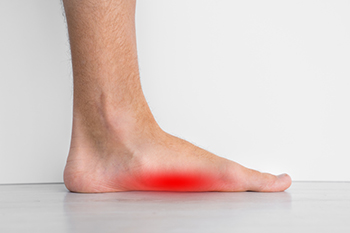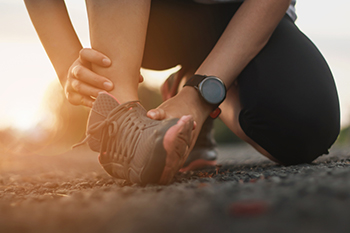NJ (908) 688-5577
NY (212) 737-2528

Athlete's foot, a common fungal infection that affects the skin of the feet, can be influenced by various environmental factors. Moisture plays a significant role in its development, as the fungus thrives in warm, damp conditions. Sweaty feet trapped in tight, poorly ventilated shoes or damp environments, like locker rooms and communal showers, create an ideal breeding ground for the fungus. Therefore, keeping your feet dry and clean is essential in preventing athlete's foot. Furthermore, sharing contaminated surfaces, such as towels or footwear, can contribute to its spread. It is critical to practice good foot hygiene and avoid sharing personal items with infected individuals to reduce the risk. Preventive measures include wearing breathable shoes, changing socks regularly, and using antifungal powders or creams. Proper foot hygiene and avoiding exposure to fungus-prone areas are key in reducing the likelihood of athlete's foot. If you have developed athlete’s foot, it is suggested that you schedule an appointment with a podiatrist for a proper diagnosis and treatment.
Athlete’s Foot
Athlete’s foot is often an uncomfortable condition to experience. Thankfully, podiatrists specialize in treating athlete’s foot and offer the best treatment options. If you have any questions about athlete’s foot, consult with Glenn Davison, DPM from Advanced Podiatry. Our doctor will assess your condition and provide you with quality treatment.
What Is Athlete’s Foot?
Tinea pedis, more commonly known as athlete’s foot, is a non-serious and common fungal infection of the foot. Athlete’s foot is contagious and can be contracted by touching someone who has it or infected surfaces. The most common places contaminated by it are public showers, locker rooms, and swimming pools. Once contracted, it grows on feet that are left inside moist, dark, and warm shoes and socks.
Prevention
The most effective ways to prevent athlete’s foot include:
Symptoms
Athlete’s foot initially occurs as a rash between the toes. However, if left undiagnosed, it can spread to the sides and bottom of the feet, toenails, and if touched by hand, the hands themselves. Symptoms include:
Diagnosis and Treatment
Diagnosis is quick and easy. Skin samples will be taken and either viewed under a microscope or sent to a lab for testing. Sometimes, a podiatrist can diagnose it based on simply looking at it. Once confirmed, treatment options include oral and topical antifungal medications.
If you have any questions, please feel free to contact our offices located in Union, NJ and New York . We offer the newest diagnostic and treatment technologies for all your foot care needs.

Living with flat feet, a condition characterized by the absence of arches on the feet, can be a lifelong experience starting in childhood. When someone with flat feet stands, their entire foot touches the ground, though in most cases, it does not lead to harm. However, some individuals may experience symptoms such as swollen ankles, difficulty standing on their toes, or pain in the foot arch area. Identifying these signs, particularly in children, is important for early intervention. While flat feet can be a natural part of a child's development, it can also develop later in life from age related factors. Seeking medical attention involves a comprehensive examination, where a podiatrist may recommend custom shoe inserts and certain exercises to alleviate discomfort. In severe cases, surgery may be considered. Home care includes minimizing stress on the feet, weight management, and, if necessary, pain relief measures. If you are experiencing discomfort related to flat feet, it is suggested that you schedule an appointment with a podiatrist for a full exam and suggested treatment measures.
Flatfoot is a condition many people suffer from. If you have flat feet, contact Glenn Davison, DPM from Advanced Podiatry. Our doctor will treat your foot and ankle needs.
What Are Flat Feet?
Flatfoot is a condition in which the arch of the foot is depressed and the sole of the foot is almost completely in contact with the ground. About 20-30% of the population generally has flat feet because their arches never formed during growth.
Conditions & Problems:
Having flat feet makes it difficult to run or walk because of the stress placed on the ankles.
Alignment – The general alignment of your legs can be disrupted, because the ankles move inward which can cause major discomfort.
Knees – If you have complications with your knees, flat feet can be a contributor to arthritis in that area.
Symptoms
Treatment
If you are experiencing pain and stress on the foot you may weaken the posterior tibial tendon, which runs around the inside of the ankle.
If you have any questions please feel free to contact our offices located in Union, NJ and New York . We offer the newest diagnostic and treatment technologies for all your foot and ankle needs.

A bunion, a prevalent foot deformity, draws attention to the joint at the base of the big toe, where a bony bump forms. This condition, known as hallux valgus, gradually develops when the big toe leans inward toward the second toe, causing the metatarsal bone to protrude. Bunions can result from genetic predisposition, wearing ill-fitting shoes that squeeze the toes, or conditions such as arthritis. The gradual misalignment of the toe joint leads to inflammation, pain, and, in some cases, difficulty in finding comfortable footwear. While bunions are often associated with discomfort and aesthetic concerns, they can also impact joint function over time. Understanding the overview of bunions involves recognizing the factors contributing to their development and the potential implications on foot health. If you have a bunion, it is suggested that you visit a podiatrist who can guide you toward effective relief options.
If you are suffering from bunion pain, contact Glenn Davison, DPM of Advanced Podiatry. Our doctor can provide the care you need to keep you pain-free and on your feet.
What Is a Bunion?
Bunions are painful bony bumps that usually develop on the inside of the foot at the joint of the big toe. As the deformity increases over time, it may become painful to walk and wear shoes. Women are more likely to exacerbate existing bunions since they often wear tight, narrow shoes that shift their toes together. Bunion pain can be relieved by wearing wider shoes with enough room for the toes.
Causes
Symptoms
In order to diagnose your bunion, your podiatrist may ask about your medical history, symptoms, and general health. Your doctor might also order an x-ray to take a closer look at your feet. Nonsurgical treatment options include orthotics, padding, icing, changes in footwear, and medication. If nonsurgical treatments don’t alleviate your bunion pain, surgery may be necessary.
If you have any questions, please feel free to contact our offices located in Union, NJ and New York . We offer the newest diagnostic and treatment technologies for all your foot care needs.

An ankle sprain occurs when ligaments are damaged due to a sudden incident, often when the foot rolls or twists beyond its usual range. This can result in the overstretching or tearing of ligaments. An inversion sprain causes strain on the outer ligaments and an eversion sprain affects the inner ligaments. Treatment for the majority of uncomplicated ankle sprains involves rest, avoiding weight on the ankle for the first 48 hours, compression using an elastic bandage, and elevating the foot to reduce swelling. If the ankle swells severely right after the injury and bearing weight is impossible, it is suggested that you schedule an immediate appointment with a podiatrist. Other signs for urgent attention include a loud crack or pop during the incident or an ankle deformity unrelated to swelling. Complete rehabilitation of the ankle joint is essential to avoid developing chronic weakness that can lead to further sprains. Among measures that can help are performing a range of motion, balance, and strengthening exercises with guidance from a podiatrist on length of time and intensity. To ensure a tailored treatment plan for a sprained ankle, it is suggested that you make an appointment with a podiatrist.
Although ankle sprains are common, they aren’t always minor injuries. If you need your ankle injury looked at, contact Glenn Davison, DPM from Advanced Podiatry. Our doctor can provide the care you need to keep you pain-free and on your feet.
How Does an Ankle Sprain Occur?
Ankle sprains are the result of a tear in the ligaments within the ankle. These injuries may happen when you make a rapid shifting movement while your foot is planted. A less common way to sprain your ankle is when your ankle rolls inward while your foot turns outward.
What Are the Symptoms?
Preventing a Sprain
Treatment of a Sprain
In many cases, the RICE method (Rest, Ice, Compression, and Elevate) is used to treat ankle sprains. However, you should see a podiatrist to see which treatment option would work best with your injury. In severe cases, surgery may be required.
It is important to ask your doctor about rehab options after you receive treatment for your injury. Stretching, strength training, and balance exercises may help the ankle heal while also preventing further injury.
If you have any questions, please feel free to contact our offices located in Union, NJ and New York . We offer the newest diagnostic and treatment technologies for all your foot care needs.

With age, the body undergoes various changes, and your feet are no exception. Senior adults often experience common foot ailments that can affect their mobility and overall well-being. Some prevalent foot ailments that seniors may encounter include plantar fasciitis, an inflammation of the ligament that runs from the heel to the ball of the foot. It causes pain in both areas and is sometimes associated with heel spurs. Bunions, also known as hallux valgus, involve a painful bony buildup on the big toe joint, often causing the big toe to bend toward the smaller toes. Heredity plays a role, and years of wearing narrow or high-heeled shoes can make it worse. Morton's neuroma, a painful condition, is caused by a swollen, inflamed nerve. It typically affects the ball of the foot between the third and fourth toes and can feel like having a small rock in the shoe. It is more prevalent in women who have worn high heels or narrow shoes. Additionally, aging can lead to a reduction in the natural padding under the feet, making it essential for seniors to choose footwear with adequate cushioning. Regular foot care, appropriate footwear, and professional guidance from a podiatrist can significantly enhance foot health. If you are a senior, it is suggested that you schedule an appointment with a podiatrist if you need help with any type of foot pain.
Proper foot care is something many older adults forget to consider. If you have any concerns about your feet and ankles, contact Glenn Davison, DPM from Advanced Podiatry. Our doctor can provide the care you need to keep you pain-free and on your feet.
The Elderly and Their Feet
As we age we start to notice many changes in our body, but the elder population may not notice them right away. Medical conditions may prevent the elderly to take notice of their foot health right away. Poor vision is a lead contributor to not taking action for the elderly.
Common Conditions
Susceptible Infections
Diabetes and poor circulation can cause general loss of sensitivity over the years, turning a simple cut into a serious issue.
If you have any questions please feel free to contact our offices located in Union, NJ and New York . We offer the newest diagnostic and treatment technologies for all your foot and ankle needs.